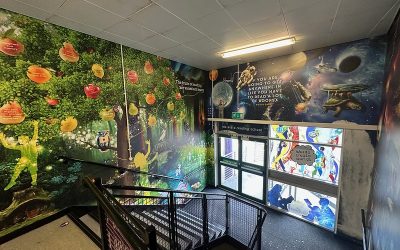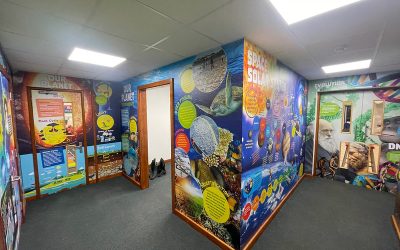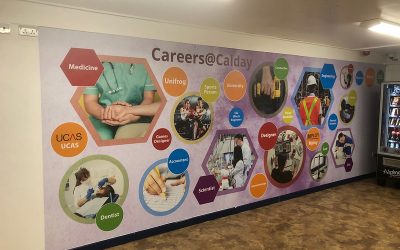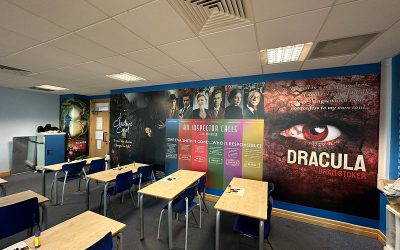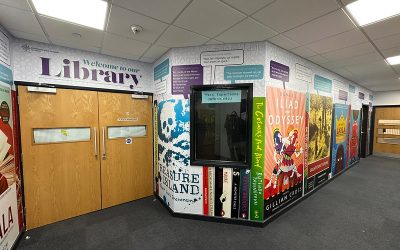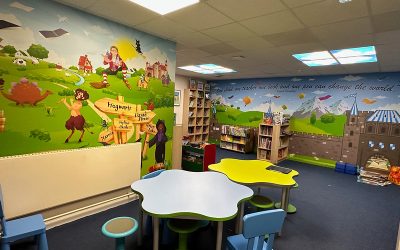School murals can be an exciting and inspirational way to engage pupils with history, a subject which requires children to commit so many facts to memory. In fact, clever use of history timelines and wall art can make the subject come alive and help pupils to memorize names, dates, and events by association to the world in which they live.
Inspirational school murals can help you to reinforce learning, reduce the workload of teachers, and stimulate young minds. The question is, how do you create the best history-specific school mural ideas?
Here are five tips for designing history timeline murals to teach history.
1. Be Clear About How You Will Use Your History Wall Art
School murals can be used in many ways. To create the best wall art for history, it’s vital that you are first clear about how you will be using it. Here are a few ideas:
- Interactive wall art
Interactive wall art is designed for teacher use, as a visual guide during lessons. This can prompt questions, discussion, and even be used as lesson guides. - Subliminal reminders
The idea here is that your wall art is viewed in passing, and this passive sight of a history timeline, for example, helps to reinforce learning subliminally.
In the book ‘Communicating with Data Visualisation: A Practical Guide’, authors Adam Frost, Tobias Sturt, Jim Kynvin, and Sergio Gallardo describe how, “even the keenest students will be fighting against the strictness and stubbornness of their working memories.” They battle against information
overload, become conservative about accepting new information, and find it difficult to memorise more than a few pieces of information (the ‘rule of seven’, which could be lower for many – consider how many of us find it hard to even remember a four-digit PIN). A well-designed and properly organized history wall mural can help by ensuring each section of information is self-contained and coherent, and that each section is relevant to those around it and to the student. And the constant viewing of this visual information helps to embed it in the memory.
- Additional learning resource
A wall chart can also be used as an additional learning resource, with teachers pointing pupils in the direction of the wall chart when completing a homework assignment, for example – and again reinforcing learning. - Encourage curiosity
Wall art can encourage children to be curious, and prompt questions and desire to investigate. If this is your aim, then using questions and effective imagery on the murals themselves can spark imagination and a desire to learn more.
2. Bring History to Life
History can be a subject in which pupils feel little attachment. Children live today, and it can be difficult for them to relate to things that happened 10 years ago, never mind hundreds of years in the past.
When designing your school’s history mural, consider how you might make history come alive by being more relevant to the pupils you are teaching. Here are a few examples to help you:
- Can you link an important event in Victorian times to the building of your school?
- Are there local landmarks that are associated with historic figures?
- Are there sites nearby where a hoard of Roman coins were found?
- Can you link sporting events (such as a pupil’s favourite team winning the FA Cup) to an important year in world history?
The secret is to help pupils link the past with the present, or with things that are important to them – “How old is your father?”… “Oh, so he was born the same year man first stepped onto the moon.”
3. Consider Where Your History School Mural Will Be
The location of your school murals might depend on several factors – how they are to be used, of course, but also space and classroom location.
You’ll need to consider lighting and size, as well as the shape of the space in which your history mural will be located: along one continuous wall; around the four walls of a classroom; up a dog-legged stairwell; opposite a floor-to-ceiling window; etc.
All such factors have an impact on effective design of wall art, as you consider:
- Colour
- Landscaping of wall murals
- Lighting
- Focal points to deliver key messages
An experienced wall art designer should ask many questions of you, to establish all the parameters in which they must work.
4. Don’t Overload!
The mural should reinforce the history curriculum, not replace it! Decide what the key facts and information are that you wish your mural to display, and limit to these. This will enable your wall art to be more attractive, better organized, and more appreciated – and a far better learning resource
because of it.
5. Support Your School’s Branding
Finally, your wall display should support your school’s brand – it’s values, mission, and purpose. Whatever the subject, pupils and visitors should be reminded of the qualities that make your school unique.
Expertise to Make Your School Murals Stand Out Within Your Budget
Peruse our case studies, and you’ll get a feel for the expertise and experience we have of designing history timeline murals and wall art for all types of schools. Your school could be transformed within your budget, too. Just select which of the two options would suit you best:
- ‘Off the shelf’ self-installation – tailored to your school for colour scheme and local history to be included
- Bespoke – Designed to include the list of historical points you wish to be featured, and designed from scratch after a site visit to discuss the project with you
To learn more about how your school could benefit from wall art as an aid to the teaching and learning of history, contact Design for Education.
More like this…
School Wall Displays: Engaging Students Beyond the Classroom
Unlock the Hidden Power of Your Educational Environment School wall displays are a powerful yet often underutilised tool in education. The power of well-designed, vibrant school wall murals goes far beyond improving the aesthetics of a school. They become an extension...
School Walls as Learning Tools: Engaging Displays for Every Subject
Reimagining School Walls for Dynamic Education In the modern education environment, using school walls as learning tools helps teaching staff to go beyond textbooks and digital screens. Indeed, they are proving to be an integral visual learning tool, with research...
How School Wall Displays Inspire Your Students
The walls of a classroom do more than just enclose a space, they also shape your students learning environment. Thoughtfully designed school wall displays can ignite curiosity, celebrate achievements, and reinforce key concepts, making learning more engaging. Whether showcasing student work, visualising complex ideas, or creating an inspiring atmosphere, well-crafted displays encourage participation as well as motivation. The right visuals can transform your classroom into a dynamic, stimulating space that supports both academic success and personal growth.
Transforming School Walls: Inspiring Educational Spaces with Custom Wall Art
Transforming school walls with custom wall art can create inspiring educational spaces that foster creativity, motivation, and engagement among students. By incorporating vibrant designs that reflect a school’s values and curriculum, such as historical timelines or scientific concepts, educators can enhance learning environments and reinforce school identity. Thoughtfully designed wall art not only creates engaging spaces but also serves as an educational tool, turning blank walls into sources of inspiration.
Using Wall Art in School Libraries to Foster a Love for Reading
Creating Dynamic Reading Spaces with Murals and Interactive Displays Employing wall art in your school library is a wonderful way to create a vibrant, inviting atmosphere that encourages students to read more. From literary-themed murals to interactive graphics,...
10 Creative Wall Art Ideas for Primary Schools
Looking to brighten up your primary school’s walls? Our team have assembled 10 creative wall art ideas for primary schools which can transform dull spaces into vibrant, educational canvases. From murals that promote core values and inspire growth mindsets to interactive literacy and numeracy walls, these designs bring learning to life. Celebrate diversity, showcase history, or create themed learning corners – each idea fosters a welcoming environment and supports students’ development. Whether indoors or outdoors, school wall art is a powerful tool to reflect your school’s ethos, enhance engagement, and inspire creativity.






